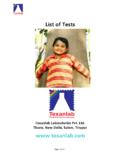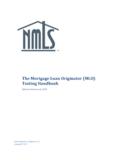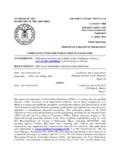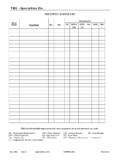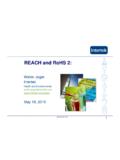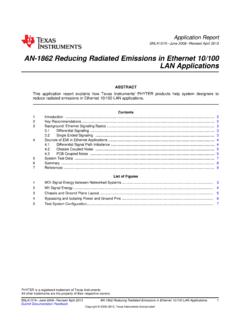Transcription of INSTITUTE OF CHARTERED SHIPBROKERS - Marine …
1 INSTITUTE OF CHARTERED SHIPBROKERS . april 2008 EXAMINATIONS. WEDNESDAY 23 april MORNING. DRY CARGO CHARTERING. Time allowed Three hours Answer any FIVE questions All questions carry equal marks 1. A shipowner for whom you act requests you to report on current market conditions and future prospects for the dry cargo bulk shipping market. Draft a message to the owner with your assessment. 2. Set out the main functions of a Bill of Lading. What steps can and should an owner take if original Bills of Lading are not available at the port of discharge prior to the vessel's arrival? 3. Using a prospective cargo and vessel of your choice, draw up a voyage calculation showing how you arrive at the daily earnings for the vessel.
2 Use this calculation to draft a firm voyage offer for the owner of the cargo. 4. Differentiate between breach of warranty of authority with negligence and breach of warranty of authority without negligence. Give examples showing possible outcomes. How can brokers protect themselves against claims for breach of warranty of authority? 5. Select one of the following trades: Iron Ore or Grain Set out the main trade routes as well as any peculiarities/hazards of carriage or routing of the selected trade. 6. Analyse the most common reasons why a vessel may be considered as being "off-hire". 1 EXREPS2008/DCC. 7. Sketch a general arrangement plan, including a midship section, of one of the following: a) Handymax bulkcarrier b) Panamax bulkcarrier c) Capesize bulkcarrier 8.
3 Describe how FFAs are entered into, how they are settled, and set out four main routes or timecharters which are regularly traded as FFAs. 2 EXREPS2008/DCC. THE INSTITUTE OF CHARTERED SHIPBROKERS . DRY CARGO CHARTERING (DCC). 2008 . EXAMINER'S REPORT. OVERALL COMMENT. A better year than the last but there are still too many very weak candidates. Regrettably many candidates failed to display any clear understanding of what a bulk carrier was and where or how it traded. Few demonstrated any depth of knowledge or ability to apply the knowledge they had to real life scenarios, as opposed to parroting what they had learnt from a book. That said, those that got high marks produced exemplary papers and should be congratulated accordingly.
4 QUESTION 1 MARKET REPORT. This question aimed to test candidates' knowledge of current market conditions. They are expected to keep up to date with reports in the media (Lloyds List for example). The answer should therefore include: A brief description of the current situation including tonnage availability and cargo demand situation. A discussion of the demand forecast. An outline of the latest order book, it is not necessary to know actual figures but an order of magnitude. Then a suggested forecast consistent with preceding arguments. There were additional marks for logic, understanding of market forces and layout of message (rather than just an essay).
5 In order to write a meaningful market report it is necessary to have an assessment of current and future supply and demand scenarios. It is not sufficient to write I think or I believe without backup. QUESTION 2 BILL OF LADING. This was by far the most popular question and one of the best answers for the majority of candidates who selected it. It was very straightforward; the main functions of a bill of lading are - Receipt; remembering quantity and condition. - Document of Title, remembering the right to claim delivery and security of payment - Evidence of Contract: with some reference to original c/p: The second part of the question was designed to test the understanding of letters of indemnity and the difference between using them for B/L that are not available and when they are used in place of clean bills (fraud).
6 Candidates should have mentioned who draws up the LOI, who holds it and how it is exchanged. There were also extra marks for good practice recommendations. It did not ask for an essay on Everything I know about Bills of Lading.. 3 EXREPS2008/DCC. QUESTION 3 VOYAGE CALCULATION. Not as popular a question as I would have expected, given that voyage calculations and voyage offers are part of the backbone of the subject. However for those who attempted it the majority got good marks. There were some who could obviously dash off an offer but did not really understand a calculation. And others who were clearly remembering something from the office but showed no real knowledge of the subject.
7 The question was designed to test candidates understanding of how the offer translates into a paid cargo for owners. The number of candidates who did not read the question properly and produced a freight rate rather than daily earnings, was disappointing. The first part of the question needed to include all the main points in order to come to the correct answer. The second part should have included all the basic points of an offer: Time and Place for reply, Cargo tonnes % moloo, Load/Discharge, Laycan, Laytime terms, Demurrage/Despatch, % brokerage, Subject c/p; not forgetting any subjects . QUESTION 4 BREACH OF WARRANTY. For this question candidates should have shown an understanding of the necessity to indicate the source of authority, that they are legally liable if unauthorised, the requirement to insert as agents only and the implications of not inserting these words (possible liability as principal).
8 They should then discuss breach with or without negligence and the associated liability. There were additional marks for mentioning all points, format and flow of logic in discussion. Few went into any detail there are 20 marks here and showing two examples of breach with and without is not going to get them. Few candidates explained authority or the full implications. QUESTION 5 TRADE ROUTES. Another popular question but with a disappointing pass rate given the two principal commodities. Answers should have included examples of trade routes with extra marks if a map was attempted. It did not need to be perfect but showing regions and ports with a map shows a much higher level of understanding.
9 Trade routes should have been described, it was not sufficient just to list them, and the top candidates mentioned weather conditions. Few mentioned any load or discharge ports and a number got coal and iron ore regions mixed up, which was worrying. The question also needed a discussion of how the cargo is stowed and any particular hazards associated with that. QUESTION 6 OFF-HIRE. This very straightforward question had one of the worst pass rates. First, candidates needed to demonstrate they understood that the vessel would be operating under a time charter contract. They should then list and describe the various conditions as per an off hire clause, Cl 15 in Asbatime (for example), with reference to whether or not they are frequent or likely.
10 Very few mentioned whether the reason was common or not and there was a certain amount of confusion with laytime terms. The question said analyse not list and candidates did not pass if they managed to reproduce a clause with no explanation. Equally this is not a legal paper and the discussion of different cases was not relevant. 4 EXREPS2008/DCC. QUESTION 7 GENERAL ARRANGEMENT DRAWING. The minimum requirement was for a side-on profile and midship section of the chosen vessel with all relevant features labelled. Bonus marks were given for accuracy, and for candidates who included a hatch plan (viewed from above). Few got the whole plan, too many made their diagrams very small with no annotations.



